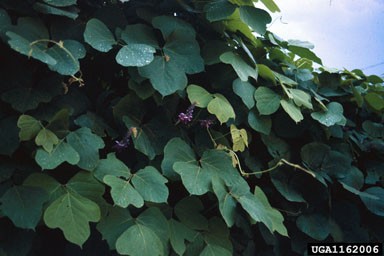Kudzu

Introduction
Kudzu is an invasive plant frequently called the “vine that ate the south” because of its fast growth and how ubiquitous it has become in the southeastern United States. While this vine, originally from Japan, was marketed as an ornamental plant or ground cover to stabilize soil, it quickly established and spread outside of where it was planted. Because it was so widely planted and grew so rapidly, many states have been managing kudzu for seventy years or more. New areas of the Midwest and northeastern U.S. also now manage for this invasive plant.
Due to its rapid growth and ability to cover any trees or structures in a thick carpet of vines, kudzu has posed concerns for forested areas and old field sites. Kudzu often prevents native plants and trees from establishing and creates a monoculture that decreases species biodiversity and reduces the ecological and economic value of infested areas.
Kudzu primarily spreads through vegetative runners, where nodes that touch the ground can put down roots and spread. While this plant can grow rapidly, even over a foot a day, there are some management options that can be used to keep vines back or control small areas of kudzu.
Identification
Younger stems are yellow-green and covered with golden/bronze bristly hairs, while older stems are woody, hairless and gray/brown in color. First year vines can reach ½ inch in diameter and older stems can be 4 inches thick. Pods are hairy and contain 3-10 seeds which can remain viable for years. Each leaf, made of 3 leaflets, can be up to 8 inches long. Leaves are large, dark green, deciduous and borne alternately along the stem. The leaf stalk and undersides of leaves are hairy. Each leaflet has toothless edges and often is notched or lobed. The middle leaflet is on a short stalk and is usually 3-lobed; the outer leaflets are 1-2 lobed. Pea-like flowers appear on spikes (up to 8 inches long) in leaf axils, blooming from base to tip. Flowers are reddish-purple, very fragrant and appear in mid to late summer. Roots may grow from nodes that have come in contact with the soil. Tubers develop at or just beneath the soil surface on major roots, and those tubers provide stores of energy for the plant to regrow; removing tubers can help manage kudzu in small areas where those roots and tubers can be pulled up manually.
Current Situation
Kudzu is a prevalent issue across much of the southeastern U.S. and is present in many counties in Tennessee. While complete eradication is not feasible across the entire state, kudzu can be managed in priority areas where species biodiversity or other ecological benefits are important. Because kudzu also frequently prevents natural regeneration of trees from establishing, kudzu management is also frequently a step in site preparation for forest management.
Management
Management of kudzu can be difficult depending on the infested area, but there are several tools available. Often these strategies are part of an integrated pest management system that utilizes multiples management tools at different stages and different times of year to control or slow the spread of kudzu. Strategies include mechanical removal of the tuber at the root crown, repeated mowing (or grazing to deplete the plant over several years, or herbicide use. Foliar herbicides can be effective for low ground-cover kudzu, and for vines that have climbed into trees or other tall structures, cut vines near the base and apply a cut-stump treatment to the end of the vine still attached to the ground. As with any pesticide use, read the label before beginning, follow all safety protocols, and ensure proper application so that the chemical is effective without wasting chemical or posing other concerns.
What Can You Do?
In small areas where mechanical removal of tubers or continuous mowing is an option, kudzu can be managed through these mechanical means. In larger areas or areas inaccessible for mechanical removal, other options may be available, such as grazing goats. Herbicides may also be used if properly applied.
Because kudzu can grow from vegetative sprouts, if mowing or otherwise using mechanical means to manage kudzu, make sure to clean mowers, spades, or other tools and equipment to prevent vegetative sprouts from being accidentally transported to other areas.